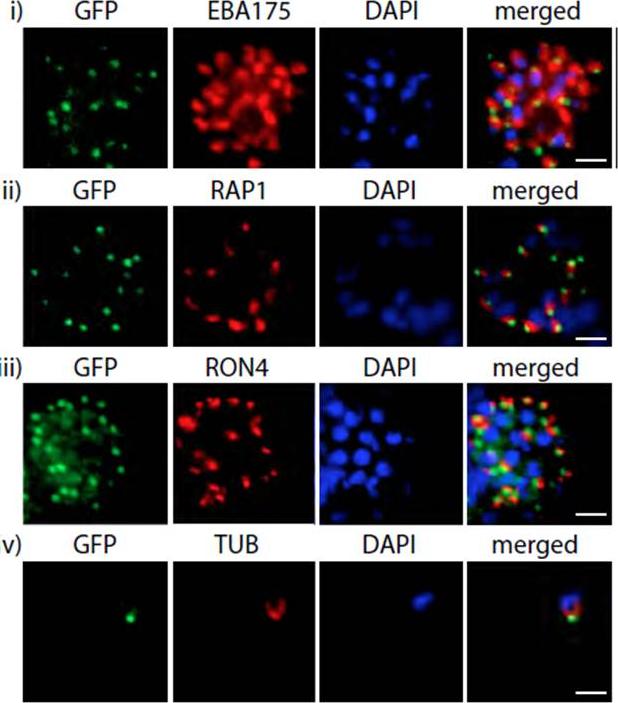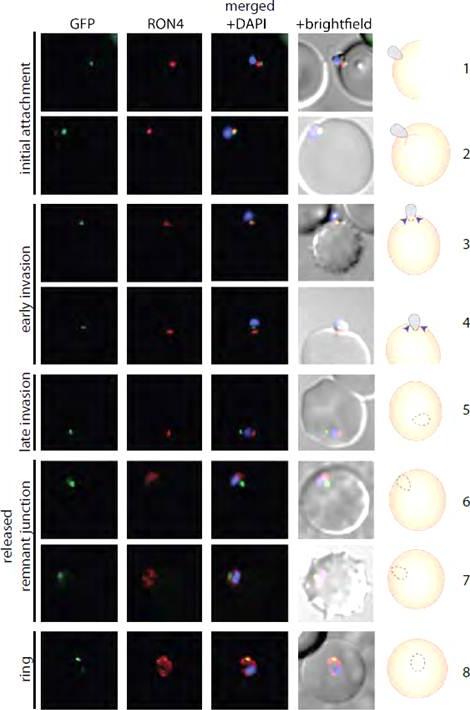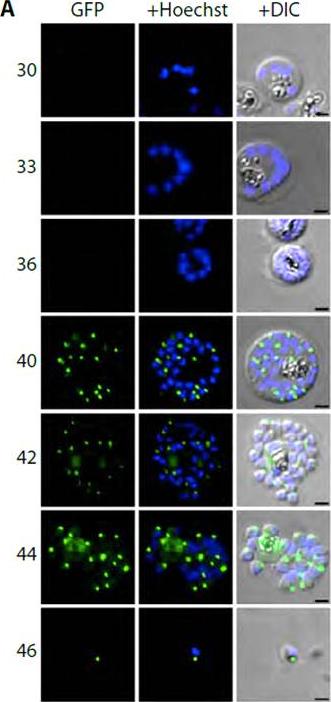PBANKA_1103300 myosin B (MyoB)
Disruptability [+]
| Species | Disruptability | Reference | Submitter | |
|---|---|---|---|---|
| P. berghei ANKA |
Possible |
PlasmoGEM (Barseq) | PlasmoGEM | |
| P. berghei ANKA |
Possible |
RMgm-4659 | Imported from RMgmDB | |
| P. falciparum 3D7 |
Possible |
USF piggyBac screen (Insert. mut.) | USF PiggyBac Screen | |
Mutant phenotypes [+]
| Species | Stage | Phenotype | Reference | Submitter |
|---|---|---|---|---|
| P. berghei ANKA | Asexual |
No difference |
PlasmoGEM (Barseq) | PlasmoGEM |
| P. berghei ANKA | Asexual |
No difference |
RMgm-4659 | Imported from RMgmDB |
| P. berghei ANKA | Gametocyte |
No difference |
RMgm-4659 | Imported from RMgmDB |
| P. berghei ANKA | Ookinete |
No difference |
RMgm-4659 | Imported from RMgmDB |
| P. berghei ANKA | Oocyst |
No difference |
RMgm-4659 | Imported from RMgmDB |
| P. berghei ANKA | Sporozoite |
No difference |
RMgm-4659 | Imported from RMgmDB |
| P. berghei ANKA | Liver |
No difference |
RMgm-4659 | Imported from RMgmDB |
Imaging data (from Malaria Metabolic Pathways)

PfMyoB-GFP is located at the apical pole of the merozoite. Indirect immunofluorescence of PfMyoB-GFP (green) with various merozoite organelle markers (red), using antisera to i) EBA175 (microneme marker), ii) RAP1 (rhoptry bulb), iii) RON4 (rhoptry neck) and iv) α-tubulin. Samples were counterstained with DAPI (blue). The merged images are also shown. Rows i-iii show individual schizonts, row iv shows an individual merozoite. Scale bar: 2 μM. Antibodies to GFP produced a compact discrete dot pattern of fluorescence located at the very apical end of the MyoB-GFP parasites, near to the localisation of the apical markers EBA175, RON4, and RAP1. However, whilst in some cases the fluorescent signal partially overlapped with these markers, MyoB appeared to be in a distinct location within the cell, anterior to the microneme marker, the rhoptry bulb, and even to the rhoptry neck.Yusuf NA, Green JL, Wall RJ, Knuepfer E, Moon RW, Schulte-Huxel C, Stanway RR, Martin SR, Howell SA, Douse CH, Cota E, Tate EW, Tewari R, Holder AA. The Plasmodium Class XIV Myosin, MyoB has a Distinct Subcellular Location in Invasive and Motile Stages of the Malaria Parasite, and an Unusual Light Chain. J Biol Chem. 2015 Mar 23.
See original on MMP
PfMyoB-GFP remains at the anterior of the merozoite during invasion of the host cell.MyoB-GFP-expressing P. falciparum parasites were fixed during various stages of invasion, then MyoBGFP (green) was revealed using rabbit anti-GFP antibodies, RON4 (red) was detected using mAb 24C6 and nuclei stained with DAPI (blue). Merged images including the DIC are shown, as well as a cartoon of the invasion stage in which the moving junction is shown by the blue arrowheads, the extracellular merozoite is grey, and the intracellular parasite is denoted by a dotted line and is uncoloured. The invasion steps have been divided into initial attachment, followed by early and late stages of invasion as well as the final steps of invasion with the release of the remnant junction and formation of the ring stage. Scale bar: 2 μM.Yusuf NA, Green JL, Wall RJ, Knuepfer E, Moon RW, Schulte-Huxel C, Stanway RR, Martin SR, Howell SA, Douse CH, Cota E, Tate EW, Tewari R, Holder AA. The Plasmodium Class XIV Myosin, MyoB has a Distinct Subcellular Location in Invasive and Motile Stages of the Malaria Parasite, and an Unusual Light Chain. J Biol Chem. 2015 Mar 23.
See original on MMP
MyoB subcellular location in asexual blood and mosquito stages. A. Microscopic analysis of live P. falciparum asexual blood stage parasites expressing GFP tagged MyoB. Shown are blood stage parasites of increasing maturity from early schizogony (two to four nuclei; 30 hours post invasion [hpi]) through to mature segmenter forms (44 hpi) and free merozoites analysed by fluorescence microscopy. GFP was detected by green fluorescence and the nuclei (blue) were labelled with Hoechst dye prior to microscopic analysis. GFP fluorescence was not detected in trophozoites (not shown) and early schizont stages, and was first apparent in mature multinucleate schizonts as a number of single dots (40 hpi). Following cytokinesis a single dot was present associated with each nucleus at what appeared to be the apical end of the cell. The images, merged with the differential interference contrast (DIC) image, are shown in the right panel. Scale bar: 2 μm. Yusuf NA, Green JL, Wall RJ, Knuepfer E, Moon RW, Schulte-Huxel C, Stanway RR, Martin SR, Howell SA, Douse CH, Cota E, Tate EW, Tewari R, Holder AA. The Plasmodium Class XIV Myosin, MyoB has a Distinct Subcellular Location in Invasive and Motile Stages of the Malaria Parasite, and an Unusual Light Chain. J Biol Chem. 2015 Mar 23.
See original on MMPMore information
| PlasmoDB | PBANKA_1103300 |
| GeneDB | PBANKA_1103300 |
| Malaria Metabolic Pathways | Localisation images Pathways mapped to |
| Previous ID(s) | PB000366.02.0, PB300310.00.0, PBANKA_110330 |
| Orthologs | PCHAS_1103000 , PF3D7_0503600 , PKNH_1029900 , PVP01_1030300 , PVX_097755 , PY17X_1104400 |
| Google Scholar | Search for all mentions of this gene |